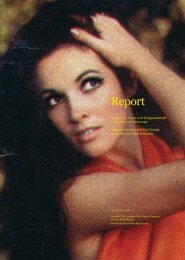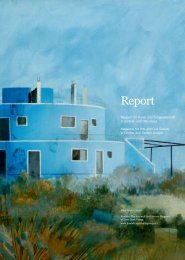Report_Issue 1/2009 - Jubiläum/ 20 Jahre Mauerfall
Report_Issue 1/2009 - Jubiläum/ 20 Jahre Mauerfall
Report_Issue 1/2009 - Jubiläum/ 20 Jahre Mauerfall
Sie wollen auch ein ePaper? Erhöhen Sie die Reichweite Ihrer Titel.
YUMPU macht aus Druck-PDFs automatisch weboptimierte ePaper, die Google liebt.
“We also see our<br />
collecting strategy<br />
as a political<br />
statement”<br />
Antje Mayer: How long has Erste Bank been<br />
collecting art?<br />
Boris Marte: Erste Bank and its Central and<br />
Eastern European daughter banks can look<br />
back on a very long tradition of collecting and<br />
promoting art. But our collection no longer related<br />
to current tendencies in the production<br />
of art and therefore did not meet the criteria<br />
of the international art market. For this reason<br />
we had our collection evaluated two years<br />
ago by Rainer Fuchs, the deputy director and<br />
academic head of MUMOK. On the basis of his<br />
thorough and critical study the partner banks<br />
in Central and Eastern Europe decided to formulate<br />
a joint strategy that would enable them<br />
to concentrate their activities in the area of collecting.<br />
We have, so to speak, embarked upon a<br />
new beginning.<br />
A conversation with Boris Marte, sponsoring director of Erste Bank until <strong>20</strong>08,<br />
on occasion of the first exhibition of the Erste Bank Group art collection at the Museum<br />
Moderner Kunst Stiftung Ludwig Wien (MUMOK) and the tranzit workshops Bratislava.<br />
— Antje Mayer talks to Boris Marte —<br />
What criteria does Erste Bank apply in building up its collection?<br />
As a bank our business focusses on Central and Eastern Europe. In terms<br />
of investigation by art historians and a functioning art market this region<br />
is still an unknown quantity. We developed our new collecting policy out<br />
of this need. This means, to a certain extent, reformulating art history<br />
and thus questioning the Western European canon of art. With this in<br />
mind we offer professional conservation, research and presentation of<br />
progressive art from the 1960s to the present day. The art we collect<br />
comes from a geopolitical area where it is rarely given the opportunity to<br />
present itself in an international context. Additionally, and this is something<br />
unique, the intention is that the collection should become a platform<br />
for dialogue, i.e., should it work on vital themes that are important<br />
to the formation of an identity for this region.<br />
That is to say Erste Bank is presenting a young<br />
collection to the public at a relatively early stage.<br />
Is this something of a risk?<br />
What is being shown in MUMOK – and it is<br />
important to emphasize this fact – are the first<br />
steps in our new activity as a collector. Individual<br />
works suggest a direction through the<br />
quality of the erratic and the particular that<br />
they bring with them. The exhibition is more<br />
a suggestion of the future than the reality of<br />
a collection. MUMOK invited us to make this<br />
exhibition. After a lengthy discussion with the<br />
art advisory council we gladly accepted this invitation.<br />
On one major condition, however: it<br />
seemed most important to us to express from<br />
the very start the international nature and the<br />
cross-border aspect of our collecting policy. For<br />
this reason we decided to hold the exhibition in<br />
two different locations at the same time, in the<br />
tranzit workshops in Bratislava and in Vienna.<br />
We were not just interested in the symbolic<br />
content of this move, we were in fact more concerned<br />
with extending the contact between two<br />
cities that is still experienced far too little.<br />
So this is not merely building up a<br />
collection of things of value?<br />
Well, we certainly want to build up an internationally successful collection<br />
that represents something of value. An integral aspect of successful<br />
collections is that, in terms of their value, the individual art works profit<br />
from being part of the collection. But you cannot remove our collection<br />
from its context. This is not possible in this cultural region and to do this<br />
would not achieve a manifestation of the works.<br />
It is noticeable that you often use the word<br />
“politics” in connection with the collection, why<br />
is this?<br />
In the sense that our collecting budget is<br />
not spent entirely on acquisitions, part of it<br />
is used to relate the collection to the region<br />
with the intention that it should be perceived<br />
as a cultural area whereas at present the way<br />
it is perceived is determined primarily by the<br />
economy. We wish to consciously provide an<br />
antipole to this. We also view our collecting<br />
strategy as a political statement in the struggle<br />
against the marginalisation of art and culture<br />
in the transformation societies and in the<br />
battle against a kind of nationalism that is, at<br />
times, most aggressive and that seeks to exclude<br />
everything that is different and diverse.<br />
The full interview was published in „<strong>Report</strong>“ in May<br />
<strong>20</strong>06 (online).<br />
87




